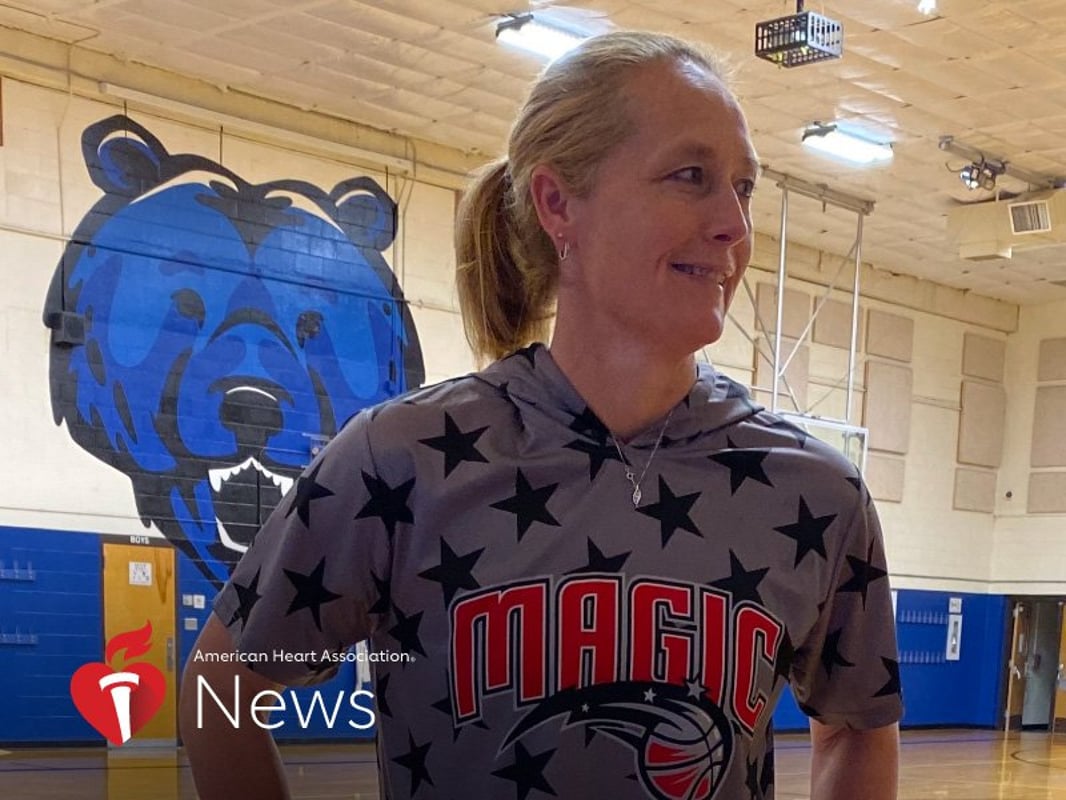AHA News: Former College Hoops Star Learned She Had a Hole in Her Heart After It Caused a Stroke

MONDAY, March 13, 2023 (American Heart Association News) -- Tamie Felty was waiting for her wife, Amy Burnett, to get dressed for brunch when she heard a crash in the bedroom.
"Hey, what's going on in there?" Felty called out.
She heard Burnett try to say something, but it made no sense.
Felty ran into the room and found Burnett on the floor, slumped against a dresser.
Felty is 5-foot-3; Burnett nearly 6 feet. So Felty couldn't move Burnett.
Then Felty noticed the left side of Burnett's face drooped and she couldn't use her left arm.
Burnett seemed to be asking for water, but Felty wasn't sure.
Felty knew the signs of a stroke include paralysis on one side and slurred speech. However, it seemed unlikely to Felty considering Burnett was only 49 and in good health.
A basketball star at the University of Wyoming in the mid-1990s, Burnett was now a physical education teacher at an elementary school in Austin, Texas, where the couple live. Burnett also was active with a nonprofit youth basketball training and development program that she'd started and Felty now runs. In fact, they're on the go so often that it was unusual for them both to be home at the same time during the day.
Still, the signs seemed obvious, so Felty called 911.
"I think my wife's having a stroke," she said.
The dispatcher asked Felty to put Burnett through a series of tests to see if she could smile, lift both arms and say a sentence.
Although Burnett flunked them all, her speech had slightly improved. She was also getting some movement back.
Paramedics arrived within 10 minutes. By then, she'd recovered enough that the first responders questioned whether Burnett was having a stroke. They said it might be Bell's palsy, a neurological disorder that causes paralysis or weakness on one side of the face.
"Then why would the rest of her left side be paralyzed?" Felty said.
She felt she had to convince paramedics that it was a stroke. Once they gave in, they suggested going to a hospital "right around the corner" instead of a stroke center "all the way downtown," Felty recalled. The paramedics let the women decide.
"The stroke center!" Felty hollered.
She kept thinking of the saying, "Time is brain." The quicker a stroke patient receives proper medical attention, the better the chance for recovery.
At the hospital, doctors confirmed Burnett had a stroke caused by a clot in her brain. Because she'd arrived so quickly – within 74 minutes of Felty calling 911 – doctors could administer clot-busting medication.
Improvement was almost immediate. Within two days, Burnett was up and walking and had regained her speech. After three days in the hospital, she was released to go home.
Burnett noticed slight deficits in her cognition. She and Felty played brain-building exercises daily to build it back up.
While Burnett was in the hospital, doctors found a cause for the stroke. She was born with a hole between the upper chambers of her heart. The hole is supposed to close on its own after birth but didn't. People who have this hole often find out under circumstances like this. Two months after the stroke, Burnett underwent a procedure to close it.
The stroke happened last July. The couple scrubbed a planned trip to Italy later that month. Burnett was told she should confine her exercise to walking until doctors could confirm the hole in her heart was fully sealed.
For an athlete, the wait was difficult. But at least Junior, their Jack Russell terrier, enjoyed his frequent walks. Finally, in October, Burnett was cleared to resume all physical activities.
Burnett's cognition continues to improve. One of her goals is to learn and retain the names of all 700 of her students.
"Sometimes Amy has trouble finding the words she wants, or her brain goes to fatigue faster," Felty said. "But she's so intelligent that she's still amazingly high functioning."
Burnett turned 50 in January and celebrated the milestone with a feeling of appreciation.
"After the stroke, my emotions were all over the place," she said. "I could have died. I could be disabled. More than anything, I feel a deep sense of gratitude. That's the reason I want to share my story."
Both she and Felty try to get the word out about knowing the signs and symptoms of a stroke.
"If it can happen to Amy, it can happen to anyone," Felty said.
Burnett even shares the information with her elementary school students.
"We do little health lessons," she said. "We talk about staying active, appreciating your bodies, and when to call 911."
American Heart Association News covers heart and brain health. Not all views expressed in this story reflect the official position of the American Heart Association. Copyright is owned or held by the American Heart Association, Inc., and all rights are reserved.
By Diane Daniel, American Heart Association News
Related Posts
Almost Two-Thirds of Women Have Troublesome Premenstrual Symptoms
WEDNESDAY, Sept. 7, 2022 (HealthDay News) -- A majority of women experience...
Three At-Home COVID-19 Tests Needed to Confirm Negative Result, FDA Says
FRIDAY, Aug. 12, 2022 (HealthDay News) -- People who test at home after being...
Study Finds No Ties Between Youth Tackle Football, Brain/Behavioral Issues
MONDAY, Jan. 3, 2022 (HealthDay News) -- Many parents struggle with the decision...
AHA News: Las complicaciones durante el embarazo podrían aumentar el riesgo de derrame cerebral a temprana edad
JUEVES, 2 de febrero de 2023 (American Heart Association News) -- Las mujeres...
